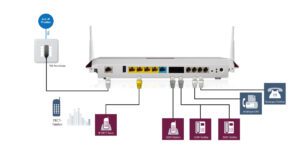 As already announced in our previous blog entry, we will have a closer look into the two ALL IP approaches: migrating the ISDN PBX or replacing it via a new IP-based voice and data solution.
As already announced in our previous blog entry, we will have a closer look into the two ALL IP approaches: migrating the ISDN PBX or replacing it via a new IP-based voice and data solution.
Migrating the ISDN PBX
Migration means continuing with the already existing PBX whilst a media gateway takes care of the ISDN connection from the PBX’s point of view. The biggest advantage related to migration is that the PBX remains unaffected. In this process the media gateway will be positioned between PBX and the ALL IP broadband connection.
It is very important to use a professional media gateway unifying all necessary interfaces and features. Sophisticated QoS (quality of services) mechanisms are in this case especially important as it guarantees the required voice quality and the solution’s reliability. One of the basic requirements is of course the available bandwidth. As a rule of thumb, a good voice quality comparable with ISDN can be obtained by allocating 100 kbit/s for each voice channel, bidirectional for up and downstream. Also qualitative parameters such as delay, jitter and an acceptable level of package loss have to be evaluated. For instance, losing 10 coherent data packages at a stretch, can lead to losing 100 to 300 ms of voice information. In order to have a smooth operation for incoming and outbound calls, the media gateway converts ISDN voice data into IP data and vice versa.
The same applies to the communication of the ISDN PBX behind. It is important to note that all data coming from or transmitted to the ALL IP platform has to be conformed and compatible with SIP which is the network protocol being used. SIP (session initiation protocol) is in charge of the control as well as the set up and dismantling of the connection. The voice data as such is transmitted via the real time protocol (RTP). Experience shows that SIP is not the same as VoIP and VoIP is not the same as ALL IP.
A simple example: The ALL IP service provider sends phone numbers in a canonical format which means that the customer number being called is for instance +49-91-196730. Without the media gateway converting the format into 091-196730 before sending it to the ISDN PBX, it is very likely that none of the phones connected to the PBX would ring. Vice versa, the same applies when calls are made from the ISDN network to the IP network.
New ALL IP solution
If the ISDN PBX which is already installed should not migrate due to technical or economic issues, then the PBX has to be replaced and an ALL IP voice data solution has to be found. However, one has to take into account that with an ALL IP solution, not only the PBX may lose functionality, but also the terminals may only be used partially or not at all. In this case new IP terminals have to be integrated. This is a cost factor not to be underestimated, especially in companies with a larger number of digital and often proprietary system terminals. However, a complete and thorough IP-based infrastructure offers plenty of opportunities to optimize working processes and thus achieves an economical benefit.
Numerous features such as DECT over IP, voice mail, IP-based door intercom including camera image of visitors on IP terminals or smart phones can be seamlessly integrated and used via professional ALL IP communication solutions. Now, wireless LAN or HotSpots for guests and customers as well as integration of home offices or mobile employees can be effectively combined.
Teldat as a qualified ALL-IP partner for SMEs, large corporations and integrators has attracted the service provider Deutsche Telekom as a customer by its various ALL-IP solutions for both approaches, migration as well as new ALL-IP solutions.

























